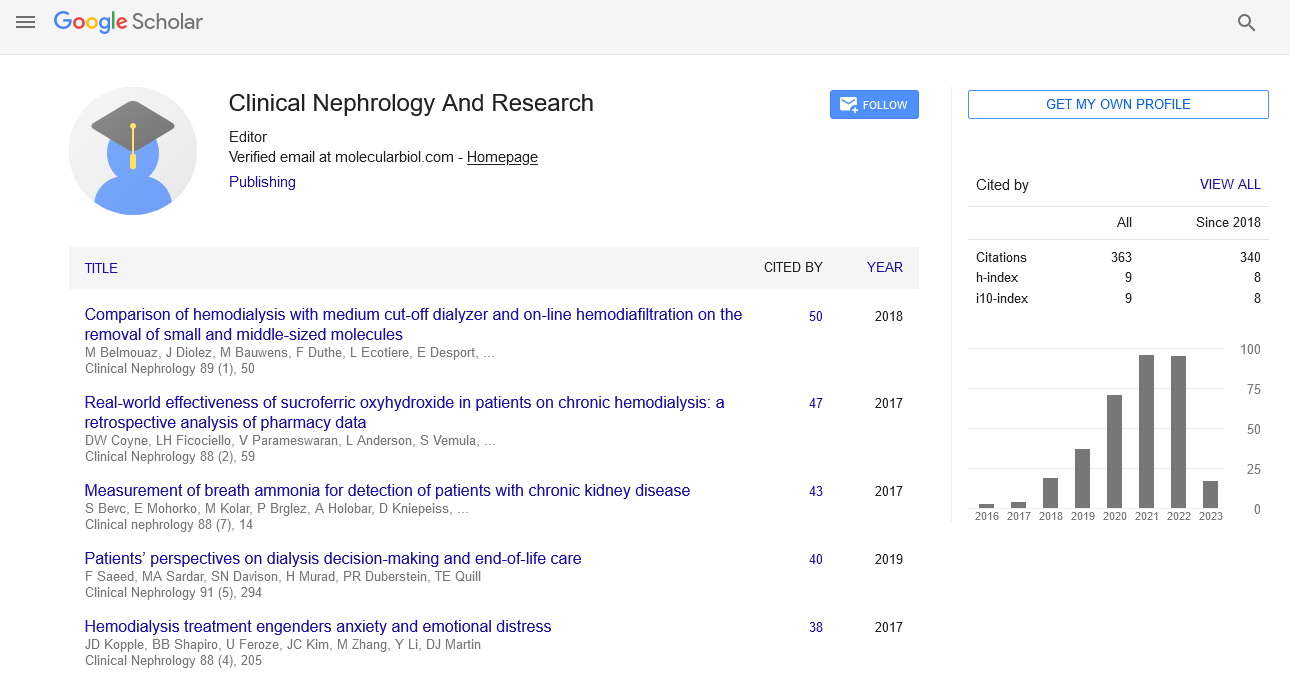Clear cell renal carcinoma: Mutations and prognosis
Received: 21-Jul-2021 Accepted Date: Aug 04, 2021; Published: 11-Aug-2021
Citation: Calzadilla ND. Clear cell renal carcinoma: Mutations and prognosis. Clin Nephrol Res 2021;5(4):1-2.
This open-access article is distributed under the terms of the Creative Commons Attribution Non-Commercial License (CC BY-NC) (http://creativecommons.org/licenses/by-nc/4.0/), which permits reuse, distribution and reproduction of the article, provided that the original work is properly cited and the reuse is restricted to noncommercial purposes. For commercial reuse, contact reprints@pulsus.com
Abstract
We study what immunohistochemical and genetic alterations of ccRCC (using MLPA) are associated with tumor prognosis and aggressiveness. An analytical study was done with 57 patients underwent radical and partial nephrectomy, where we found that CAIX and tumor size were associated with worse Fuhrman grade. Certain genetic mutations (CDKN2A, BRCA1 and 2, p53, APC, MDM2, WT1) were associated with worst prognosis and death.
Keywords
Clear cell renal carcinoma; Multiplex ligation-dependent probe amplification; Carbonic anhydrase IX; Cyclin-dependent kinase Inhibitor 2A; BRCA1 y 2; p53
Description
Renal cell carcinoma accounts for 2%-3% of all tumors being the most frequent solid lesion in the kidney. Despite the improvements and increased range of imaging techniques for initial diagnosis, 17% of all patients are diagnosed with metastatic disease [1] and almost 20% of patients who undergo nephrectomy have disease recurrence during follow-up [2]. There is a clear association between Clear Cell Renal Carcinoma (ccRCC), smoking, hypertension and obesity [3], being the genotype of each individual is a key piece in the oncogenesis of this disease.
The biology of the von Hippel-Lindau gene producer and its regulation of Hypoxia-Inducible Factor (HIF) are linked to its etiology [4]. MLPA (multiplex ligation-dependent probe amplification) is a method of multiple PCR that through a single pair of primers, allows you to carry out the amplification of multiple sequences diana of DNA. This is a quick method, reliable, effective and low cost compared with other techniques [5].
In this study we determined what genetic alterations (using MLPA) and ImmunoHistoChemical (IHC) of ccRCC were associated with prognosis and tumor aggressiveness. We found that Carbonic Anhydrase IX (CAIX) and tumor size were associated with worse Fuhrman grade, as well as diverse specific genetic mutations (CDKN2A, BRCA1, BRCA2, p53, CCND2, APC, MDM2, WT1, CDK4, EBF1, DLEU1 and RUNX1) were associated with worst prognosis and death [6].
Other important knowledge are related with BRCA1 mutation associated with protein 1 (BAP1) occurs in 5%-15% of ccRCC cases and is associated with worse clinical outcomes [7]. Mutations in the Polibromo-1 (PBRM1) gene, common in 40% and the BRCA1 gene associated with BAP1, are key events in the genesis of this tumor [8]. Study of ccRCC nowadays via genetic analysis allows us to obtain more information on the characteristics of each patient tumor and predict which will behave most aggressively, but it does not yet allow us to calculate probability models for use in daily clinical practice.
More research is warranted to specify in more detail if the mutations found may be applicable in clinical decision making. At the moment, surgery is the most important part of the treatment for the majority of patients.
The key is finding signals in the tumors that allow us to decide when being more aggressive during this process. The indication of Lymph Node Dissection (LND) during partial or radical nephrectomy is still controversial [9]. In a large retrospective study, the outcomes of radical nephrectomy with or without LND in patients with high-risk non-metastatic renal clear cell were compared using a propensity score analysis. In this study LND was not significantly associated with a reduced risk of distant metastases, cancerspecific or all-cause mortality.
The extent of the LND was not associated with improved oncologic outcomes [10]. Otherwise, could be possible a good medical therapy in some cases?; there is currently no evidence that medical adjuvant therapy offers a survival benefit [11], however immune checkpoint inhibitors, indicated to restore and enhance immune activity against cancer cells, have shown impressive efficacy in the metastatic disease. Probably the recent future will be an adequate combination of precise surgery in select patient (with good genetic and immunohistochemical information) and immune checkpoint inhibitors, but only in the next years we will know it.
REFERENCES
- Capitanio U, Montorsi F. Renal cancer. Lancet. 2016;387(10021):894-906.
- Athar U, Gentile TC. Treatment options for metastatic renal cell carcinoma: a review. Can J Urol. 2008;15(2):3954-66.
- Chow WH, Dong LM, Devesa SS, et al. Epidemiology and risk factors for kidney cancer. Nat Rev Urol. 2010;7(5):245-57.
- Latif F, Tory K, Gnarra J, et al. Identification of the von Hippel-Lindau disease tumor suppressor gene. Science. 1993; 260(5112):1317-20.
- Schouten JP, McElgunn CJ, Waaijer R, et al. Relative quantification of 40 nucleic acid sequences by multiplex ligation-dependent probe amplification. Nucleic Acids Res. 2002;30(12):e57.
- Diez-Calzadilla NA, Noguera Salvá R, Soriano Sarrió P, et al. Genetic profile and immunohistochemical study of clear cell renal carcinoma: Pathological-anatomical correlation and prognosis. Cancer Treat Res Commun. 2021;27:100374.
- Joseph RW, Kapur P, Serie DJ, et al. Loss of BAP1 protein expression is an independent marker of poor prognosis in patients with low-risk clear cell renal cell carcinoma. Cancer. 2014;120(7):1059-67.
- Chow WH, Dong LM, Devesa SS, et al. Epidemiology and risk factors for kidney cancer. Nat Rev Urol. 2010;7(5):245-57.
- Latif F, Tory K, Gnarra J, et al. Identification of the von Hippel-Lindau disease tumor suppressor gene. Science. 1993; 260(5112):1317-20.
- Schouten JP, McElgunn CJ, Waaijer R, et al. Relative quantification of 40 nucleic acid sequences by multiplex ligation-dependent probe amplification. Nucleic Acids Res. 2002;30(12):e57.
- Jocham D, Richter A, Hoffmann L, et al. Adjuvant autologous renal tumour cell vaccine and risk of tumour progression in patients with renal-cell carcinoma after radical nephrectomy: phase III, randomised controlled trial. Lancet. 2004;363: 594-9.





